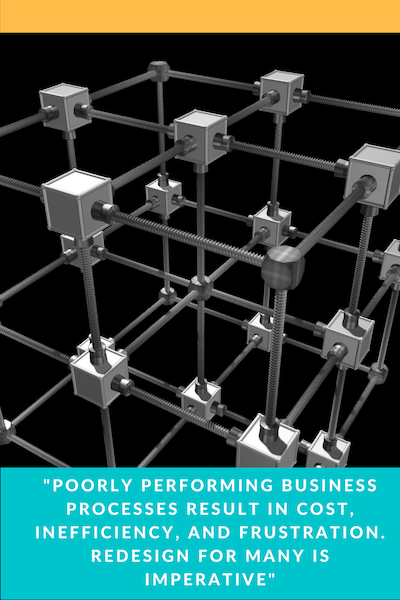 In business, we use processes every day they are fundamental to a business functioning effectively and their robustness likely governs whether or not a business performs well.
In business, we use processes every day they are fundamental to a business functioning effectively and their robustness likely governs whether or not a business performs well.
Poorly performing business processes result in cost, inefficiency, and frustration. Many businesses spend an enormous amount of time in reviewing, tuning and developing it’s processes that it becomes, machine-like, efficient.
But what makes a badly performing process? Poor performance might be down to a number of factors from a lack of understanding regarding the steps, poor interaction between stakeholders or errors built into the steps themselves. There’s an excellent breakdown of why processes failover here. Perhaps for me, the most common issues are departmental interdependencies and process rigidity, but each and every business will have its issues.
Clearly, it should be in all business interests to constantly evaluate and improve their business processes. There’s a multitude of resources around detailing process improvement steps. It’s not overly complicated but it does require resource and time.
Here’s our guide to the key steps:
1/ Map the existing process
This doesn’t require fancy software and (can be done with paper and a pen). There are a number of methods from merely listing boxes on paper to represent the steps through to value stream mapping but the key is to map the inputs and outputs and key steps. Mapping what actually happens now is called the current state.
2 Analyze the process.
With the process captured it’s time to look at what works and what doesn’t. Any corresponding process data that you have at this stage can be enormously useful. For example a list or rejects for any products, non-conformities, customer complaints – any info on what goes wrong and why. Our piece on RCA (root cause analysis may be of use)
Often this step is best achieved through brainstorming with a team that includes the actual process operators and customers of the process.
3 Process redesign
Taking your analysis into account look to redesign and improve the process taking into account:
A) Inputs
B) Outputs
C) Steps
D) Decisions
E) Resources
Use a team to help brainstorm the process. This ideally should include those who will be involved in the process. Consider everyone’s ideas and input and use tools like FMEA, risk to hone the process.
As you develop it, you may be faced with some decisions based on resources and cost.
It’s a good idea when looking at your process to consider how it will be measured. What data the process generates and how it can be captured and utilized to inform those monitoring the process on its performance
Implementation and communication
Once your process has been redesigned and agreed it can be deployed. What’s critical here is how the process will be communicated. It’s imperative that this is done effectively. You may have the best process in the world but if it’s not properly communicated then you’ll struggle.
Understand that change is rarely simple. Once a process has been redesigned there may be teething problems with the initial rollout, take things steady and look to evaluate early after its deployment.
Next steps
With your process redesigned and deployed you could be forgiven in thinking your job is done but business processes management is all about continual improvement. The process should be cyclical, monitor and improve – monitor and improve.
Got some thoughts on process redesign and improvement? We’d love to hear from you in our comments section below.